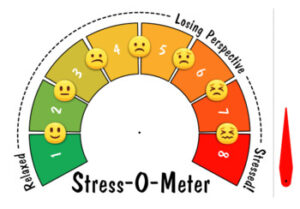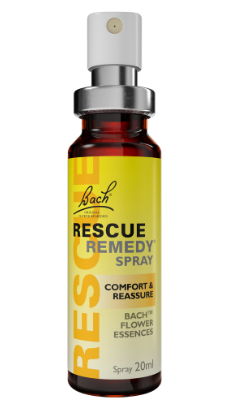Imagine, at this very moment, that inside you exists a kind of stress-o-meter. For most of us, the stress-o-meter probably looks a bit like this:

In terms of the under-the-hood mechanics of stress, modern neurology can illuminate what’s transpiring at each of these different levels:
0-1: Blissfully Relaxed (Ventral Vagal State)
– Feeling safe, calm, and connected
– Engaged and present in the moment
– Open to social interactions
– Physiological functions are balanced
2-3: Mildly Alert (Mild Sympathetic Activation)
– Slightly heightened sense of awareness
– Mild increase in heart rate
– Still feeling safe but more alert
– Ready for action if needed
4-5: Alert and Focused (Sympathetic State)
– Increased heart rate and respiration
– Feeling of alertness and focus
– Ready for action, fight or flight response activated
– Decreased sense of safety (this is where we start to feel ‘off’)
6-7: Highly Stressed (High Sympathetic Activation)
– Significant increase in heart rate and respiration
– Feeling of tension and stress
– Hyper-vigilant and overly alert
– Struggling to stay calm and connected
8-9: Overwhelmed (Transition to Dorsal Vagal State)
– Feeling overwhelmed and unable to cope
– Beginning to shut down and withdraw
– Struggling with feelings of helplessness and hopelessness
– Decreased social engagement
10: Freaking Out/Shutdown (Dorsal Vagal State)
– Complete shutdown, feeling of numbness and disconnection
– Overwhelmed by feelings of helplessness and despair
– Physiological functions are depressed
– Disengaged from the environment and others
From the perspective of our stressed-out human-animal Body-Heart-Mind systems (the three “centers of intelligence” we might say), it doesn’t really matter how this stress was generated. It might have been created by an interpersonal difficulty, a circumstantial setback, a loss in our lives, health concerns, or workplace pressure.
The only thing that truly matters for our well-being is monitoring when we’re entering the red zone (this starts to happen around the 4-5 mark with usually somewhat subtle cues that can sometimes be missed), and then acting promptly and effectively, just like applying the brakes of a car when sensing danger ahead. Most of our most profound distress and suffering often results from not having been able to apply some of this early intervention.
 With this in mind, we all could probably benefit from carrying around in our pockets the psycho-spiritual equivalent of Bach’s Rescue Remedy, which, as the spray applicator promises, is designed to produce a state-shift of COMFORT & REASSURANCE.
With this in mind, we all could probably benefit from carrying around in our pockets the psycho-spiritual equivalent of Bach’s Rescue Remedy, which, as the spray applicator promises, is designed to produce a state-shift of COMFORT & REASSURANCE.
How does one achieve this? with just three quick spritzes (let’s say 3-4 minutes) of Self-Rescue?
To achieve balance, it seems that it might be best to first attend to our oldest intelligence, the Body system, evolved over 3-4 billion years. Next, the heart system, developed over 100 million years ago. And only finally, once having comforted and reassured, those systems, do we engage with our newest layer, the mind or head system system, which has only really been for about 300,000 years of our evolutionary history.
Here’s a “Cheat Sheet” to use after you’ve practised this a few times with the audio so that you can work on having it as part of your go-to “psycho-spiritual toolkit”:
4-Minute Rescue Remedy Cheat Sheet
Minute 1: Body Centre
- Initial Assessment: Rate stress level on a 1-10 scale.
- Breath & Anchor: Deep breath, focus on nostrils and upper lip.
- Grounding Imagery: Visualise tree/mountain or ancient oceanic self.
- Movement: Optional shoulder circles or hula hoops.
- Sensory Integration: Merge stress into tapestry of oceanic sensations.
Minute 2: Heart Centre
- Focus Shift: Hand over ribcage.
- One True Friend: Connect to inner, unconditionally loving self.
- SAAAAD Emotions: Address Sad, Anxious, Alone, Ashamed, Angry, Dismissive.
- Reassuring Responses: Imagine comforting words from One True Friend.
- LACED Emotions: Connect to Love, Acceptance, Curiosity, Expectation, Desire/Drive.
- Wave of Kindness: Allow gentleness to wash over you.
Minute 3: Head Centre
- Focus Shift: Move attention to head space.
- Throne of Wisdom: Visualise control tower of being.
- Activated Receptivity: Unite body, heart, and mind.
- Deep Knowing: Access wellspring of thoughts and intentions.
- Polyvagal Activation: Deep breaths, yawn, sigh, or hum.
Post-Practice
- Re-assessment: Rate stress level again.
- Next Steps: Choose from repeating practice, breathing exercises, physical movement, soothing sounds, journaling, or focused activity.
Optional Tools
- Breathing Practices: For deeper calm (e.g. try some of these)
- Physical Exercise: To release tension.
- Soothing Sounds: To calm the mind.
- Journaling: Dialogue with One True Friend.
- Focused Activity: Engage in a meaningful task.
